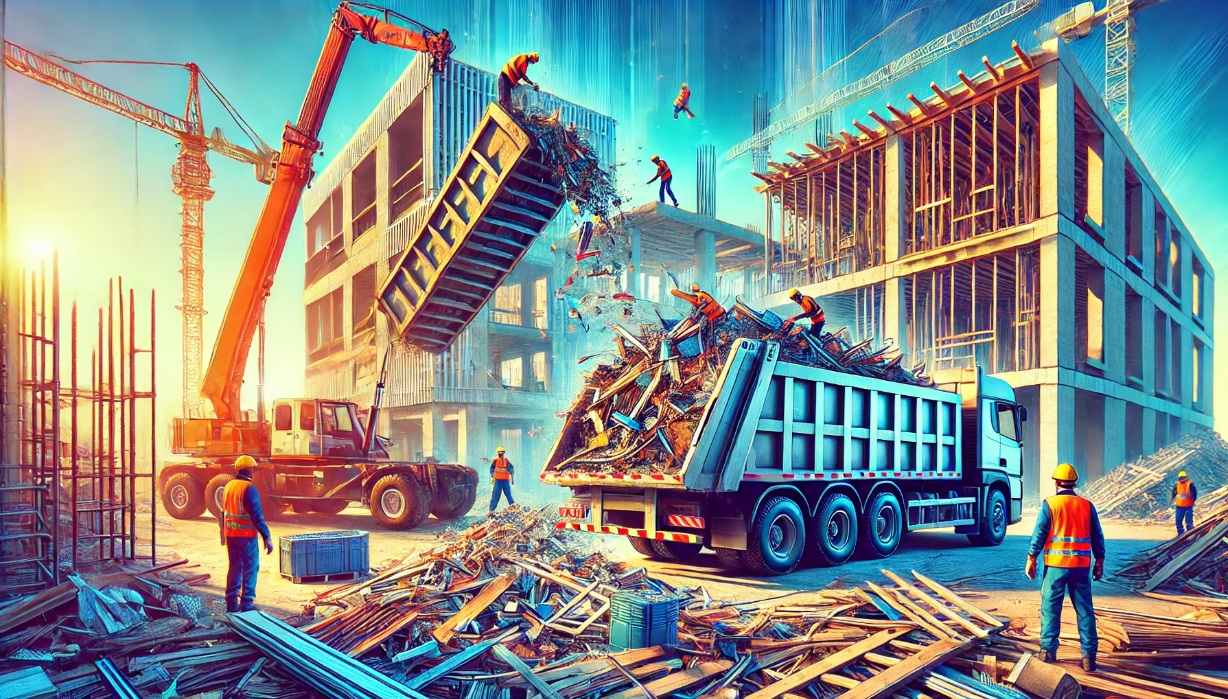
Construction Debris Removal: The Essential Guide for Clean and Safe Worksites
Construction projects can be messy—from broken concrete to piles of lumber and metal scraps, the debris builds up fast. Whether you're working on a home renovation, office build-out, or a large-scale development, removing construction debris quickly and safely is essential. Professional construction debris removal services offer an efficient way to keep your site clean, compliant, and safe for workers.
What Is Construction Debris Removal?
Construction debris removal is the process of clearing waste materials generated during construction, renovation, or demolition projects. These materials can include anything from broken tiles and concrete to scrap metal and wood. Instead of handling the cleanup on your own, professional junk removal services step in to haul away the mess, ensuring your worksite stays safe and clutter-free.
These services cater to:
- Small home renovations
- Large commercial construction projects
- Landscaping and outdoor improvements
- Demolition cleanups
Why Is Construction Debris Removal Important?
Construction debris removal is not just about keeping things tidy—it plays a vital role in project safety, efficiency, and compliance with local regulations. Here’s why it matters:
- Safety First: Construction debris, if left unattended, can pose significant safety hazards. Workers may trip over materials or get injured by sharp or heavy debris.
- Compliance with Local Regulations: Construction sites are subject to specific waste disposal regulations. Improper disposal of debris can lead to fines or legal issues.
- Project Efficiency: A clean and organized worksite leads to better productivity. Workers can move freely and complete tasks without debris getting in the way.
- Environmental Impact: Responsible construction debris disposal helps reduce landfill waste, promotes recycling, and ensures hazardous materials are handled correctly.
Types of Construction Debris
Different construction projects generate different types of waste. Understanding the materials involved helps in planning for removal and disposal. Here are some common types of construction debris:
- Concrete and Asphalt: Broken sidewalks, foundations, and driveways often result in chunks of concrete and asphalt.
- Wood: Leftover lumber from framing, old decks, and wooden trim are common materials found on construction sites.
- Drywall and Plaster: During renovations, walls and ceilings made of drywall or plaster often need to be torn down and replaced, generating a lot of dust and debris.
- Metal: Steel beams, copper pipes, and aluminum siding often pile up during both construction and demolition phases.
- Glass: Windows, mirrors, and glass doors need careful removal to avoid injury or breakage.
- Roofing Materials: Shingles, tiles, and other roofing debris add up quickly during roof replacements or repairs.
- Hazardous Materials: Asbestos, lead paint, or certain chemicals require specialized handling and disposal.
How Construction Debris Removal Works
Here’s a step-by-step overview of how professional construction debris removal services typically work:
- Initial Consultation and Quote
You contact a debris removal company to provide details about the type of debris and the size of your project. Based on your needs, they give you a free estimate. - Scheduling
Once you agree on a price, schedule a time for the crew to come to the construction site. Many companies offer same-day or next-day service to keep your project on track. - On-Site Assessment
When the crew arrives, they assess the site and confirm the volume of debris. If any hazardous materials are present, they will inform you of any special handling required. - Debris Removal
The team will collect, load, and remove all debris from the site. Most companies handle everything from small residential jobs to large commercial projects. - Disposal and Recycling
After removal, the debris is sorted to determine what can be recycled, donated, or disposed of in an eco-friendly manner. This step is essential for minimizing the environmental impact of construction waste.
Benefits of Hiring a Professional Removal Service
There are several advantages to using a professional construction debris removal service:
- Time-Saving: A removal service can clean up large amounts of debris quickly, allowing your project to continue without unnecessary delays.
- Compliance: Professional companies ensure that all debris is disposed of according to local laws, preventing fines or penalties.
- Safety: With proper equipment and trained workers, the removal process is safer for both the crew and the construction workers.
- Eco-friendly Disposal: Many junk removal companies prioritize recycling and donation, reducing the amount of waste that ends up in landfills.
| Material | Disposal Method |
|---|---|
| Concrete | Crushed and reused in new builds |
| Metal | Recycled for scrap |
| Wood | Donated or repurposed |
| Drywall | Recycled for new gypsum products |
| Hazardous Materials | Special handling and disposal |
Eco-friendly Construction Debris Disposal
Sustainable construction practices are becoming increasingly important in the industry, and eco-friendly debris disposal is a big part of that. Here are some ways to ensure your construction waste is handled responsibly:
- Recycling Materials: Items like concrete, metal, wood, and asphalt can often be recycled. For example, concrete can be crushed and reused for road bases or new construction projects.
- Donating Usable Items: Unused or gently used materials like wood beams, windows, or doors can be donated to local organizations or reused in other projects.
- Composting Organic Waste: For landscaping projects, tree trimmings, and other organic materials can be composted instead of tossed into a landfill.
- Proper Disposal of Hazardous Waste: Materials like asbestos or lead paint must be handled by professionals with experience in hazardous waste disposal to protect both the environment and public health.
FAQ: Common Questions About Construction Debris Removal
Q1: How much does construction debris removal cost?
The cost depends on the size of the job, the amount of debris, and the location. On average, removal can cost between $300 and $800 for a full truckload. Smaller loads may cost less, while larger commercial projects can cost more.
Q2: Can I recycle construction debris?
Yes, many materials like concrete, metal, and wood can be recycled. Be sure to ask your removal company about their recycling practices.
Q3: What if my construction debris includes hazardous materials?
Hazardous materials like asbestos or lead paint require special handling and disposal. Inform your removal service in advance, and they’ll guide you through the proper procedures.
Q4: How quickly can I schedule a debris removal service?
Many companies offer same-day or next-day service. It’s always a good idea to schedule in advance, especially for larger projects.
Q5: Will the debris removal company clean the site after removing the waste?
Yes, most professional services will leave your site clean and clear of debris once the removal process is complete.
Construction projects are messy, but debris removal doesn’t have to be. By hiring a professional construction debris removal service, you can keep your worksite safe, compliant, and environmentally responsible. Whether you’re remodeling a home or managing a large-scale development, debris removal services provide an efficient solution that keeps your project on track.
Have a construction project that needs debris removal? Contact a trusted service today and enjoy the benefits of a cleaner, safer worksit.
Cities We Serve
Virginia Beach Local Resources
- Virginia Beach , VA
- Norfolk, VA
- Portsmouth, VA
- Chesapeake, VA
Dumpster Rental Sizes
Business Hours
- Mon - Fri
- -
- Sat - Sun
- Closed
All Rights Reserved | Johnny Bobby's Junk Hauling & Roll-Off Dumpsters
Powered By Junk Removal Money

